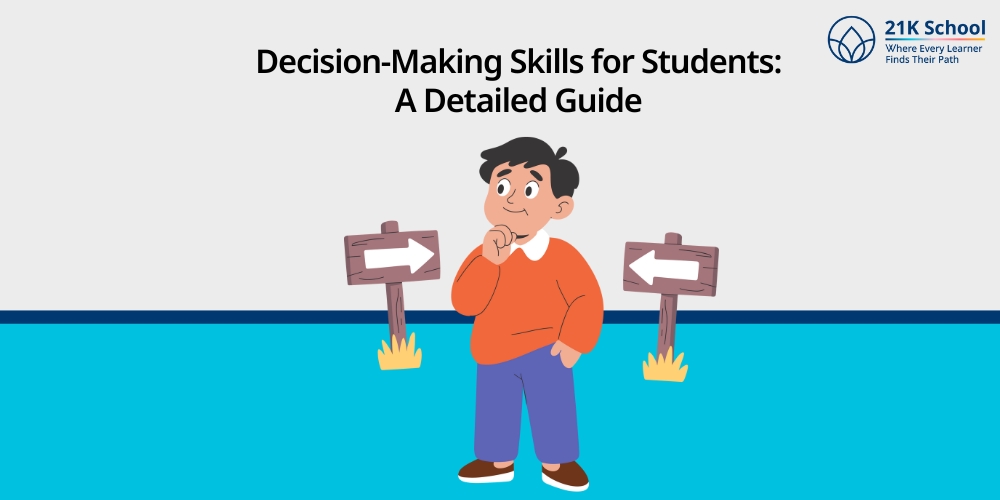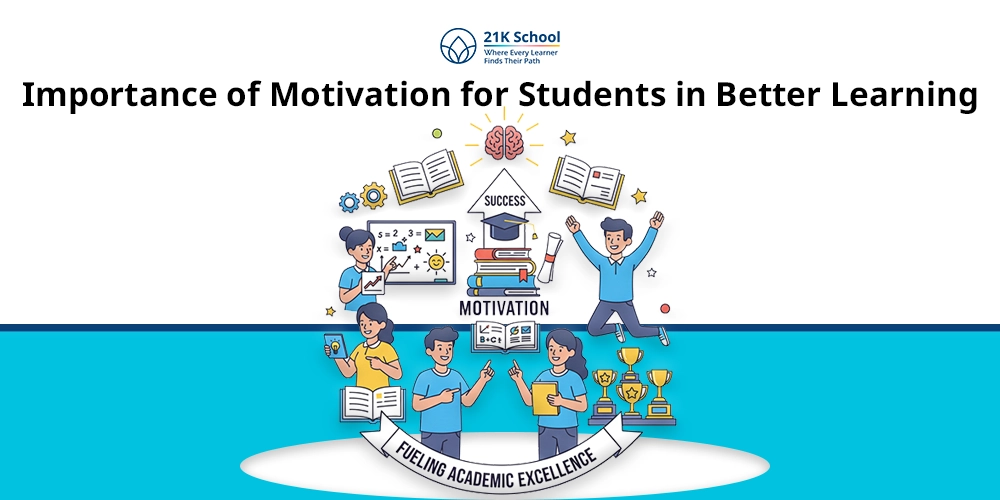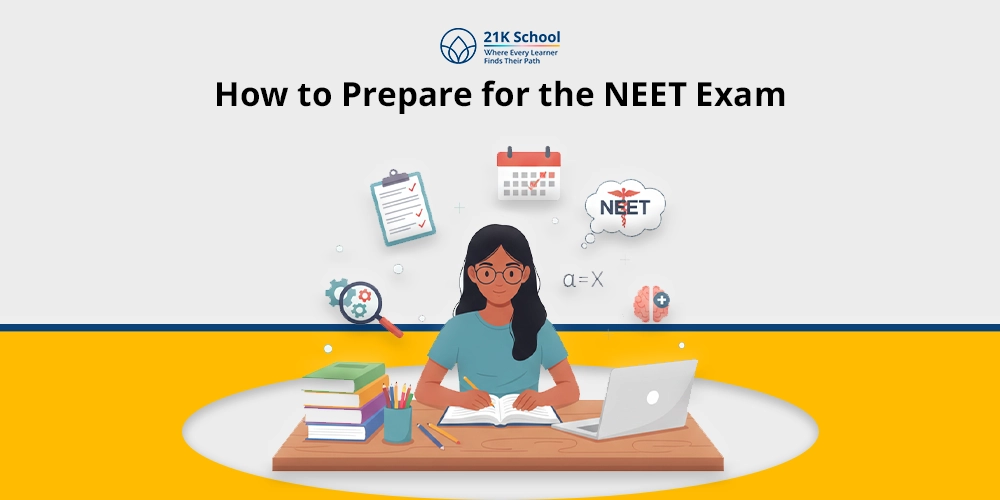
So why are decision-making skills important for kids?
Decision-making is the ability to make quick decisions in any situation. But that’s not about picking between two subjects. It’s critical thinking, emotional regulation, values, priorities and responsibility.
Making decisions early helps kids in school and in life.
Whoever has good decision-making skills in education or work can look at the facts – the current state, the goal state – and say what to do next.
Let us try to understand more on these essential decision-making skills in detail.
Table of Contents
What are Decision-Making Skills?
Decision-making skills are important to education, both in academic and personal life spheres. Those are skills that students, teachers and administrators need to succeed in the educational system.
For students, decision making involves weighing options versus consequences – and taking the best course of action in choosing courses / managing time / dealing with academic problems.
They help people take responsibility for what they learn, solve problems and adapt to new situations. Also, in education decision making demands critical thought/self-reflection and responsibility besides – all of which are necessary for personal and academic success.
Types of Decisions Students Face Daily
Students make decisions every day about their grades, relationships, personal growth and long term goals. The following are decisions students make every day.
1. Academic Decisions
Academic decisions are choices students make about education and learning. Those are how they use their time/study time table, stay organised, stay focused on schoolwork.
Such decisions affect their academic performance and progress. Whether it’s how much effort to put into a subject, when to do homework or how to study for exams – these are daily decisions that affect the future.
2. Social Decisions
Social decisions involve student relationships with teachers, classmates, friends and relatives. All these choices affect relationships & communications as well as how students are perceived by others.
Students choose who they spend time with, how they treat others and how they respond to social situations every day. Becoming kind, respectful and inclusive can create good relationships and a nice social environment.
3. Personal Decisions
Students make everyday decisions about themselves – their behavior & their health – personal decisions. So they’re about how they deal with emotions, health, routines and personal issues. They include choices about honesty, responsibility and treatment.
These choices affect childrens mental health and self esteem. Learning to make good personal decisions teaches students to be responsible, self-aware adults who can take care of themselves.
4. Future-Oriented Decisions
The decisions for what comes next comes under the future-oriented decisions. They are setting goals, imagining what kind of life or career they want and making choices that support those long-term goals.
And even little things today like learning a new skill or staying focused in school can affect what happens next. Making future-oriented decisions helps students stay motivated and on a course to a good life.
The 7-Step Decision-Making Process for Students
And as a decision-making life skill, it’s an extremely important one – particularly for students who are making choices that influence their academic and personal success. Some steps students can take when making decisions.
Step 1: Identify the Decision You Need to Make
The first step is to define the decision. And that means understanding the decision you need to make & why. Vague problems cause confusion – be specific.
Ask yourself what result you hope to get and how the decision relates to your goals/duties. That’s the starting point of the whole process. Without clarity you waste time on the wrong issues. Frame the decision so you can move forward with purpose and direction.
Step 2: Gather Relevant Information
When you have defined the decision, collect all the information needed for rational thought. That means facts & figures, advice & perspectives on what is available. And your decision depends a lot on how good the information is. Do your homework objectively – look at different sources/points of view.
Be aware of internal and external information. More data reduces uncertainty and helps you evaluate alternatives. That step requires thought rather than guesswork or emotional responses.
Step 3: Identify All Possible Alternatives
Once you know the choice is yours and you know the info is there, write down all the options. Limit yourself to the obvious/most common choices. Be creative and critical – there are more paths than you think.
Suppose you want to go to college or trade school, take a gap year or get into the workforce after high school for example. All options should be considered – even the risky ones. It is a menu of realistic possibilities.
Step 4: Weigh the Evidence and Consequences
Check out each alternative’s pros and cons. Ask yourself how each choice will affect you short & long term – academically, financially, emotionally and socially. You rank options according to how closely they fit your goals, values and priorities.
You can use charts or pros-and-cons lists or just talk through options with someone you trust. That helps you decide which alternatives are best and which have too many downsides.
Step 5: Choose Among the Alternatives
Take your time weighing your options. Choose the alternative that fits your goals, values and resources. Fear or pressure will not make you choose – make your choice.
If the choice isn’t perfect; Most decisions involve some uncertainty. But it matters that you did so thoughtfully. Pick what gives you room for growth or adaptation. So judge well & make good choices – every decision is a lesson.
Step 6: Take Action
It’s time to act on that decision. That means planning the steps to move forward and doing so. Without action, you have no decision power.
Take a class, start a project or apply for a job – get involved!, and if that is hard – adapt without losing hope. Taking action gives you momentum, confidence and accountability. Your willingness to act says you care about the decision.
Step 7: Learn from Your Decision
So what worked/what would have worked better? And every decision – good or bad – teaches lessons. Find out how you think – where you can improve – and what you can do better in the future.
Some decisions get you unexpected results. The key is to be open to learning so you can make better decisions moving forward. Such reflective practice builds character, resilience and self-development.
Proven Decision-Making Frameworks for Students
Some of the proven decision-making frameworks for students are:
1. The DECIDE Model
You can make structured decisions with the DECIDE model. It starts with identifying the problem and deciding what factors are important. After that comes the decision making – which option is best – and then action.
Once you make the decision, it helps to look back on it. In this model, decisions are broken down into steps.
2. The WRAP Framework
By promoting broader thinking people avoid common decision mistakes. WRAP framework challenges students to look at more than one or two options.
They also help you test stuff out with real experience – taking a break – and being ready for things not going according to plan. With this framework we get rid of bias and impulsiveness. You can use it for more emotional things like resolving conflicts, choosing a future path or evaluating friendships.
3. The Cost-Benefit Analysis Method
This helps students contrast the benefits and harms of each choice. They can list what they gain and lose by each option.
This is practical – you use it to manage time, spend money or join activities. It is not perfect but it teaches students trade-offs.
4. The 10/10/10 Rule
With the 10 / 10 / 10 Rule, students ask themselves how they’ll feel about a decision in 10 minutes, 10 months and 10 years. It forces long-term thinking instead of making choices based on current emotions or pressures.
This is useful in emotional/peer-influenced situations like arguments, social dilemmas or risky choices. They are reminded that short-term feelings are fleeting but some decisions are permanent. That rule teaches you self-awareness and social responsibility.
Final Thought
Decision-making is a life skill for students. So it is about analysing situations, options, choices with respect to goals, values.
Having this skill at an early age improves academic performance, problem solving and emotional intelligence. Thinking critically helps students deal with challenges, manage time and plan for the future.
Decision making is a lifelong skill with the right guidance & practice – helping learners in both the personal and academic journeys with clarity, independence and confidence.


